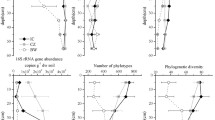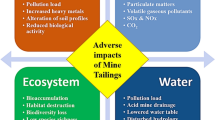Abstract
Purpose
The impacts of mining contaminations and physico-chemical properties and geochemistry of mine tailings on the density, richness, biodiversity, evolution and succession of plant species and vegetation recovery in the mining area is very poorly reported in the literature. Therefore, the present study conducted an investigation on vegetation development and succession of plant communities at the abandoned São Domingos pyrite mining area.
Materials and methods
We conducted the field survey to estimate the vegetation development and succession of plant communities, collect vegetation (plant species, lichen and moss) and tailing (and soil) samples, and finally analyzed the physico-chemical and geochemical properties and metal levels in mine tailings, soil and vegetation samples.
Results and discussion
The results showed that the communities of low height and biomass like grass, legume, shrub, moss and lichen were dominating on the mine tailings and waste dumps at the inner sites and center of the mine, and the vegetation coverage was explicitly very poor. The reddish brown colluvia had poor soil quality, but high acidity and metal concentrations. However, at the outer edge of the mine the loamy soil and relatively lower acidity and metal contamination favored the higher vegetation cover and a gradual increase in the number of species and plant succession, where the taller, higher biomass and broad leaf trees were abundantly grown forming a dense forest and canopy. The succession of several plant communities dominating in the mining area, vegetation coverage and species richness were strongly related to the different levels of contamination, soil properties and adverse factors of mine tailings.
Conclusions
Although the high concentrations of toxic trace elements and low pH soil are important factors for limiting the plant growth, however, proper soil development with enriched nutrients and properties on mining wastes, by either natural or external soil aided process, can help to promote the high vegetation growth, mine rehabilitation and ecological restoration of the mining degraded lands.



Similar content being viewed by others
References
Alloway BJ (1990) Heavy metals in soil. Blackie, London
Anawar HM, Freitas MC, Canha N, Santa-Regina I (2011) Arsenic, antimony, and other trace element contamination in a mine tailings affected area and uptake by tolerant plant species. Environ Geochem Hlth 33:353–362
Bagatto G, Shorthouse JD (1999) Biotic and abiotic characteristics of ecosystems on metalliferous mine tailings near Sudbury, Ontario. Can J Bot 77:410–425
Blaylock MJ, Huang JW (2000) Phytoextraction of metals. In: Raskin I, Ensley B (eds) Phytoremediation of toxic metals—using plants to clean up the environment. Wiley–Interscience, New York, pp 53–56
Bowen HJM (1979) Environmental chemistry of the elements. Academic, London
Chiu KK, Ye ZH, Wong MH (2006) Growth of Veteveria zizanoides and Phragmites australis on Pb/Zn and Cu mine tailings amendment with manure compost and sewage sludge: a green house study. Bioresour Technol 97:158–170
Garcia-Sanchez A, Alvarez-Ayuso E (2003) Arsenic in soils and waters and its relation to geology and mining activities (Salamanca Province, Spain). J Geochem Explor 80:69–79
Gaspar OC (1998) Historia da mineracao dos depositos de sulfuretos macic os vulcanogenicos da Faixa Piritosa Portuguesa. Boletim de Minas 35(4):401–414
Gawel JE, Ahner BA, Friedland AJ, Morel FMM (1996) Role of heavy metals in forest decline indicated by phytochelatin measurements. Nature 381:64–65
Gee GW, Bauder JW (1986) Particle-size analysis. In: Clute (ed) Methods of soil analysis. Soil Sci Soc Amer Inc Publ, Madison, WI
Hammel W, Debus R, Steubing L (2000) Mobility of antimony in soil and its availability to plants. Chemosphere 41:1791–1798
Hernández AJ, Pastor J (2008) Relationship between plant biodiversity and heavy metal bioavailability in grasslands overlying an abandoned mine. Environ Geochem Hlth 30:127–133
Herrick GT, Friedland AJ (1990) Patterns of trace metal concentration and acidity in montane forest soils of the northeastern United States. Water Air Soil Pollut 53:151–157
Hooper DU, Vitousek PM (1997) The effects of plant composition and diversity on ecosystem processes. Science 277:1302–1305
Hooper DU, Vitousek PM (1998) Effect of plant composition and diversity on nutrient cycling. Ecol Monogr 68:121–149
Hsu MJ, Selvaraj K, Agoramoorthy G (2006) Taiwan’s industrial heavy metal pollution threatens terrestrial biota. Environ Pollut 143:327–334
Ives AR, Cardinale B (2004) Food-web interactions govern the resistance of communities after non-random extinctions. Nature 429:174–177
Jackson ML (1960) Soil chemical analysis. Prentice-Hall, Englewood Cliffs, NJ
Kandeler E, Kampichler C, Horak O (1996) Influence of heavy metals on the functional diversity of soil microbial communities. Biol Fert Soils 23:299–306
Khan AG, Kuck CT, Chaudhry M, Khoo CS, Hayes WJ (2000) Role of plants, mycorrhizae and phytochelators in heavy metal contaminated land remediation. Chemosphere 21:197–207
Koptsik S, Koptsik G, Livantsova S, Eruslankina L, Zhmelkova T, Vologdina Z (2003) Heavy metals in soils near the nickel smelter: chemistry, spatial variation and impacts on plant diversity. J Environ Monitor 5:441–450
Ma LQ, Kenneth MK, Tu C et al (2001) A fern that hyperaccumulates arsenic. Nature 409(6820):579
MAFF (Ministry of Agriculture, Fisheries and Food) (1993) Code of good agricultural practice for the protection of soil. MAFF, London, p 55
Maiti SK, Nandhini S (2006) Bioavailability of metals in fly ash and their bioaccumulation in naturally occurring vegetation: a pilot scale study. Environ Monit Assess 116:263–273
Miyawaki A, Okuda S, Fujiwara R (1994) Handbook of Japanese vegetation (new revised edition). Shibundo, Tokyo, p 910, in Japanese
Nakamura Y (1986) Alpine wusten vegetation. In: Miyawaki A (ed) Vegetation of Japan: Kanto. Shibundo, Tokyo, pp 382–385 (in Japanese with German title)
Oguro T, Takeuchi K, Imagawa T, Takaoka S (1990) Vegetation changes caused by smoke damage in the Agatsuma sulfur mine, Gunma prefecture, central Japan. J Japanese Inst Landsc Archit 53:151–156 (in Japanese with English abstract)
Oshima Y (1988) Succession of biological community. In: Oshima Y, Okuma M, Sato M, Takahashi K, Mizuno T, Yamada A (eds) Biology. Asakura, Tokyo, pp 253–258
Parmeggiani L (1983) Encyclopedia of occupational health and safety. International Labor Organization, Geneva
Pitchel J, Kuroiwa K, Sawyer HT (2000) Distribution of Pb, Cd, and Ba in soils and plants of two contaminated sites. Environ Pollut 110:171–178
Reeves RD, Baker AJM, Brooks RR (1995) Abnormal accumulation of trace metals by plants. Mining Environ Mgt 3:4–8
Salminen J, van Gestel CA, Oksanen J (2001) Pollution induced community tolerance and functional redundancy in a decomposer food web in metal-stressed soil. Environ Toxicol Chem 20:2287–2295
Sheppard SC (1992) Summary of phytotoxic levels of soil arsenic. Water Air Soil Pollut 64:539–550
Shimai S (1984) Vegetation of destruction area in sulfur mines. Bull Daito Bunka Univ 22:197–204 (in Japanese with English abstract)
Shimano K (2007) Key points of regeneration-dynamics study in forests and fields. In: Minami Y, Okitsu S (eds) Basic master: ecology. Ohmsha, Tokyo, pp 30–56 (in Japanese)
Takeuchi K, Shimano K (2009) Vegetation succession at the abandoned Ogushi sulfur mine, central Japan. Landsc Ecol Eng 5:33–44
Tan KH (1996) Soil sampling, preparation and analysis. Marcel Dekker, NY
Vangronsveld J, Van Assche F, Clijsters H (1995) Reclamation of a bare industrial area contaminated by non-ferrous metals: in situ metal immobilization and re-vegetation. Environ Pollut 87:51–59
Vangronsveld J, Colpaert JV, Van Tichelen KK (1996) Reclamation of a bare industrial area contaminated by nonferrous metals: physicochemical and biological evaluation of the durability of soil treatment and revegetation. Environ Pollut 94:131–140
Vidic T, Jogan N, Drobne D, Vilhar B (2006) Natural revegetation in the vicinity of the former lead smelter in Zerjav, Slovenia. Environ Sci Technol 40:4119–4125
Wong MH, Wong JWC (1990) Effects of fly ash on yields and elemental composition of two vegetables. Brassica parachinensis and B chinensis Agric Ecosyst Environ 30:251–259
Wong MW (2003) Ecological restoration of mine degraded soils, with emphasis on metal contaminated soils. Chemosphere 50:775–780
Yoon J, Cao X, Zhou Q, Ma LQ (2006) Accumulation of Pb, Cu and Zn in native plants growing on a contaminated Florida site. Sci Total Environ 368:456–464
Yuasa Y, Murai H, Hamaura K, Inoue K (1995) Soil properties of revegetated open-cut mining lands in the past Matsuo sulphur mine, Iwate Prefecture. J Sci Soil Manure Jpn 66:520–526
Acknowledgments
This research work was supported by the Fundação para Ciência e Tecnologia (FCT, Portugal) through research contract PTDC/AMB/65462/2006-HYPERAS. The principal author (H.M.A) thanks FCT for his post-doctoral grant.
Author information
Authors and Affiliations
Corresponding author
Additional information
Responsible editor: Peter Schroeder
Rights and permissions
About this article
Cite this article
Anawar, H.M., Canha, N., Santa-Regina, I. et al. Adaptation, tolerance, and evolution of plant species in a pyrite mine in response to contamination level and properties of mine tailings: sustainable rehabilitation. J Soils Sediments 13, 730–741 (2013). https://doi.org/10.1007/s11368-012-0641-7
Received:
Accepted:
Published:
Issue Date:
DOI: https://doi.org/10.1007/s11368-012-0641-7




